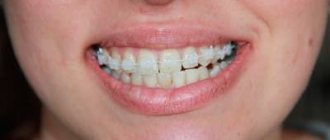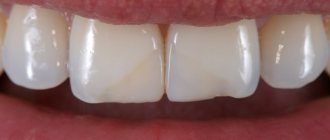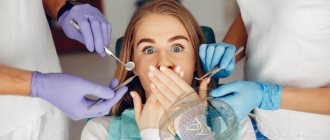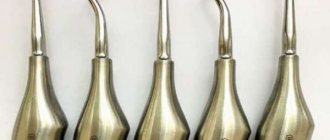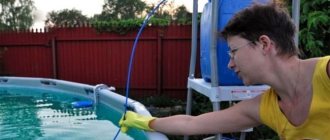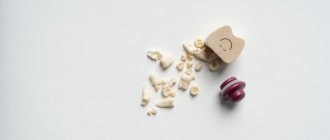Trainers for correcting crooked teeth - a convenient and effective method of bite correction
Modern orthodontics has many different hardware techniques for correcting bites. One of these is a method of correcting defects using dental trainers - these are removable structures made of soft silicone, visually reminiscent of mouthguards for athletes. Unlike braces, they do not force you to change your diet and go through a difficult adaptation period. It is enough to wear such devices for several hours during the day and put them on at night. For more information about whether trainers straighten teeth, how long they should be worn, and which type to choose in your particular case, read further in this material.
Adults
Many adults whose front teeth are far from ideal refuse to wear braces for one reason or another. It is for such patients that the T4A trainer was created, which allows you to straighten your teeth. This device is made of super-elastic polyurethane, which has good shape retention and easily adapts to any dental arch shape.
Purpose:
- Straightening front teeth without braces.
- Alignment of the front teeth in combination with additional devices for expanding the dental arch.
- The final stage of orthodontic treatment.
- Elimination of harmful myofunctional influences and habits.
- Correction of disocclusions of permanent occlusion.
- Correction of minor relapses.
Advantages:
- has the same size;
- T4A does not require individual manufacturing;
- wireless device;
- low cost.
For what reasons can a malocclusion develop?
Before moving on to questions about how to properly wear trainers to straighten teeth and how much they cost, you should consider the main reasons leading to the formation of dental anomalies. So, among the provoking factors, experts in the field of orthodontics identify the following prerequisites:
- bad childhood habits, such as holding a finger in your mouth while sleeping or sucking on a pacifier,
- incorrect position of the frenulum, the need to trim it,
- mouth breathing as a consequence of diseases of the ENT organs,
- artificial feeding - pediatricians note that when a baby is fed through a bottle, his jaw muscles tense less, which slows down the process of their proper development,
- hereditary predisposition,
- disturbances in the process of intrauterine development of the fetus, its infection, disruptions in metabolism - all this can most directly affect the correct formation of the dental system1,
- chronic, viral and infectious diseases in the mother during pregnancy.
Bad childhood habits can lead to malocclusion.
Other reasons can also provoke problems, for example, birth trauma or doctor errors during the removal of baby teeth. Other possible prerequisites include disruptions in the process of teething, poor nutrition, and a lack of vital vitamins and microelements in the body.
Trainer - application features and operating principle
We are talking about comfortable silicone structures that look like boxing mouthguards, but have a completely different purpose. This is an effective corrective system that is prescribed to correct dental defects in children and adults. Among the undeniable advantages are that they are easy to put on and take off at any convenient time, are unpretentious in care and do not require constant wearing. It is enough to wear the mouthguard on your teeth for several hours during the day and put it on at night before going to bed.
The method helps to correct the bite, normalize the functioning of the masticatory elements, straighten crooked units and, in some cases, eliminate the provoking factor. So, for example, this technique is widely used to restore proper breathing through the nose, normalize swallowing function and tongue position to form correct diction. In other words, the orthodontic design forces the muscles of the oral cavity to work correctly and trains them to function correctly.
Trainers are especially common for straightening teeth in children, since at an early age it is much easier to correct the position of individual units - bone tissue is easier to influence from the outside. On the other hand, such aligners are often prescribed to adult patients, but mainly for the correction of minor defects or as part of complex orthodontic treatment.
Kinds
There is another classification; each of the types of devices listed below is intended for use in certain situations and conditions.
- A trainer for braces (can be soft or hard) is used as an addition to treatment with braces, protects soft tissues from damage by braces and speeds up the treatment process.
- Preorthodontic (can be soft or hard) is intended to correct pathologies of primary occlusion.
- The joint relieves pain and tension in the muscles. Used to eliminate symptoms of dysfunction of the temporomandibular joint.
- The final one ensures consolidation of the achieved results of previously carried out orthodontic treatment on all kinds of fixed appliances.
- For athletes (boxing splint) used in dangerous sports.
- For adults, it is intended for the treatment of permanent dental occlusion without braces, eliminates mouth breathing and snoring.
And now more detailed information about some species.
Strengths and weaknesses of the technique
The use of such structures is a method that has become widely popular among patients of different age categories. Experts in the field of orthodontics include the following points as the main advantages:
- the device is removable, which makes it possible to easily eat food and carry out daily hygiene procedures,
- the aesthetics of the smile does not suffer, since the product only needs to be worn for a couple of hours day and night while sleeping,
- treatment does not require frequent visits to a specialist, correction and other procedures,
- the design is easy to maintain,
- discomfort during the adaptation period is reduced to a minimum,
- it is possible to select both the desired size and degree of rigidity of the device, taking into account the patient’s age and the goals pursued,
- affordable cost of treatment.
Trainers are often used to straighten teeth
“I used to have some problems with my teeth, but I categorically did not want to get braces. My job involves constant communication with people. Then the orthodontist offered me an alternative - trainers. I wore them for about 2 years, strictly according to the doctor’s instructions. I didn’t feel any particular pain or discomfort even in the first days and nights. True, this method does require self-discipline. Fortunately, I’m completely okay with this.”
Anatoly V., 31 years old, from correspondence on the forum www.32top.ru
Despite such an impressive list of advantages, the technique also has its disadvantages. So, for example, while wearing a trainer, a complete ban on eating and talking is imposed. The patient will have to strictly adhere to the indicated duration of wearing, and do not forget to put on the device, otherwise it will be very difficult to achieve the desired result. Another disadvantage of the system is its relative efficiency. Products are prescribed to correct minor deviations, but in complex cases they are powerless.
Cost of devices
The use of trainers to straighten teeth is the most cost-effective way to restore bite in adults and children. The cost of trainers ranges from 3 to 5 thousand rubles.
depending on the region of location and the type of design chosen. To the price of the structures themselves, you should add the cost of treatment by a dentist and orthodontist, their consultations and further medical monitoring.
The approximate cost is shown in the table:
| Type of dental simulator | Price in Moscow pharmacies |
| Children's preorthodontic | From 3 thousand 500 rub. |
| Finishing | From 4 thousand 500 rub. |
| Articular | From 2 thousand 500 rub. |
| Adults | From 4 thousand rubles |
| Trainers for braces | From 3 thousand 500 rub. |
In what cases are they prescribed and what are the contraindications?
It is possible to identify a number of specific phenomena and conditions for which treatment using trainers is prescribed. Here are the main indications:
- impossibility of installing a bracket system for any reason,
- deviations in the process of growth and formation of the lower jaw,
- slight crooked teeth, crowding,
- bad habits that lead to deformation of the dentofacial apparatus, for example, mouth breathing or thumb sucking during sleep,
- incorrect position of the tongue, disturbances in its functioning,
- mild malocclusion,
- excessive pressure from soft tissues on the dentition,
- retention period after the main treatment.
It is possible to use trainers after treatment with braces.
But this technique may not be applicable in all cases. For example, if there are serious problems associated with nasal breathing, or a pathological lateral bite is diagnosed. Trainers are not prescribed to patients with mental disorders when the person is not able to independently control the course of treatment. As mentioned above, such corrective mouthguards will not help correct complex anomalies, so the advisability of their use in each individual case is best left to the discretion of a specialist.
Construction of simulators for teeth straightening
The first dental trainers were invented just over 20 years ago by the Australian company Myofunctional Research Co. Exercise machines are made from polyurethane and silicone and come in soft (blue or blue) and hard (red or pink).
Externally, they look like mouth guards for the upper and lower jaws, which consist of:
- recesses for teeth;
- lip bumper;
- labial arch;
- internal tongue stop;
- marker tongue.
The trainers have a universal shape, so when installing them there is no need to additionally take impressions and waste time on the production of an individual device.
The devices correct the bite gradually and almost imperceptibly.
Varieties and popular models
The products are not created individually for each patient, so they are easier and faster to purchase. However, there are different types of such mouth guards. Your treating specialist will help you choose the appropriate option. So, for example, there is an age gradation, as well as a classification according to the degree of severity. Let's look at 3 main models: for children, adults, and also for braces.
T4K – for children
The model is aimed at correcting baby teeth or during their replacement by permanent ones. Such products are thin enough to make the child feel as comfortable as possible. In the anterior section there is a special protrusion for the tongue. Trainers for children are presented in two variations: the blue model is softer and more flexible and is used in the initial stages of treatment, while the pink model is based on a fairly rigid frame, and this device begins to be worn only some time after the start of the course. The duration of therapy usually varies from 1 to 2 years. The cost of the product is from 3000 rubles.
Design for children T4K
T4A – for teenagers from 10 years old and adults
Such devices are prescribed to children over the age of 10 years, for example, when for some reason it is not possible to install braces. It is important that at the start of the course the child has already formed a permanent bite. The elastic product has a sufficient degree of rigidity to relieve tone from the chewing muscles and correctly distribute the load throughout the entire dental system. These trainers are available in a universal size, and treatment can last up to 3 years. The cost of the model starts from 4000 rubles.
Teen model T4A
Т4В – for braces
The device is used as both a preventive and curative device for patients of all ages. Usually this model is combined with braces - it allows you to enhance the effect and consolidate the result. The design fits tightly to the staples, which also helps protect the mucous membrane from damage by hard parts of a fixed device. Treatment on average takes from six months to several years, and the cost of the device starts from 3,500 rubles.
T4B trainers are worn over braces
Myobrace is a leader in orthodontic trainers
The Australian company MRC is the undisputed leader in the market of myofunctional orthodontic systems. The manufacturer has been producing its products since 1991. We are talking about a patented development, which is a set of trainers made of high-quality silicone. The products allow you to straighten out curvatures in rows, create favorable conditions for proper growth and formation of the dental system, and get rid of mouth breathing and diction disorders.
Myobrace is a leader in trainers
The Myobrace system for adults is available in three variations:
- A1 – the model is intended for the initial stage, it is a fairly soft mouthguard that allows you to get rid of bad habits and prepare the jaws for the main treatment,
- A2 - is prescribed to correct pronounced disorders and has a more rigid plastic frame in its design, which has a targeted effect on the frontal group of teeth,
- A3 is the most rigid model, which is switched to at the final stage of treatment, and is also prescribed as a retainer.
Clinical studies confirm that the Myobrace system can achieve significant results in both children and adults.
Read more about Myobrace systems in our special material.
Indications
Elastic positioners eliminate bad habits: they wean children from sucking fingers, biting nails, and grinding their teeth. But most often they are used in orthodontics to treat various dental pathologies. These include:
- crowding of teeth, characteristic of the period of replacement of primary molars with molars;
- deep bite, accompanied by improper closure of teeth;
- speech defects;
- wide interdental gaps;
- mouth breathing in a child;
- curvature of incisors and canines;
- abnormal bite (when closing, half of the upper and half of the lower rows overlap).
A dental trainer for correcting dental defects is used instead of a brace system if a person is allergic to metal.
How to put on and use mouth guards
At the appointment, the orthodontist will definitely explain in detail how to put on the structure and how to wear it correctly in order to achieve the desired effect. The patient must strictly adhere to the doctor’s instructions and monitor the treatment process with full responsibility. Instructions for use can be presented as follows:
- the device must be placed in the oral cavity in such a way that the central stop is directed towards the upper palate and rests against the tip of the tongue, without causing excessive tension and discomfort,
- Next, the structure needs to be clamped so that the plates are securely attached to the teeth and stop slipping,
- it is necessary to squeeze the jaws, but without excessive force - until you feel light pressure on the teeth,
- after this you need to tighten your lips and take a few deep breaths through your nose,
- then you can time the time during which you need to wear the mouth guard - in the meantime, you cannot unclench your lips, eat, drink or talk,
- At the end of the session, you need to carefully remove the structure from the mouth and rinse it in clean water.
The photo shows the design while being worn.
If you wear the mouthguard longer than expected, it’s okay. The main thing is that you do not experience significant discomfort because of this, although this only happens in very rare cases. But it is highly not recommended to remove the trainer ahead of time - this will significantly reduce the effectiveness of therapy.
How long does the adaptation period last?
To understand how to properly put a mouth guard on your teeth, you need to listen carefully to the orthodontist - at the appointment, the doctor will explain in detail how to use the device and give clear instructions regarding the duration and frequency of wearing it. During the session, the patient should breathe exclusively through the nose. Typically, the design is recommended to be worn for 1-2 hours during the day and put on at night - that’s another 8-10 hours. An entry-level soft product is worn for an average of 6-8 months. Then they switch to more rigid models - according to indications.
Features of storage and care
The design is easy to care for, but to maintain general oral hygiene you need to know how and with what to clean the dental trainer. Here's what experts suggest on this matter:
- the product should be washed in water at room temperature - too cold or hot water can lead to deformation of the polymer,
- It is not recommended to use aggressive cleaners and rinses - a soft toothbrush and toothpaste will be quite enough,
- The mouthguard should be stored in a special case, protected from dust and dirt - included in the kit,
- during the session, you should not try to artificially increase the impact of the mouthguard by squeezing the jaws,
- you will have to limit your alcohol consumption, stop smoking,
- For periodic antiseptic treatment, use only approved compounds.
The device must be stored in a special container.
From time to time it is worth visiting the orthodontist’s office so that he can assess how effectively the treatment is going and whether there are any mechanical damages to the device. Don’t forget that you should visit your doctor at least twice a year for prevention and professional cleaning of plaque and deposits.
Read more about professional teeth cleaning in our special article.
Advantages of trainers over braces
Given a choice, many patients prefer convenient removable systems over braces. Among the key advantages of the former, it is worth highlighting the following points:
- the opportunity to begin treatment up to 5-6 years, immediately after changing the temporary bite,
- no embarrassment or psychological discomfort - the system only needs to be put on for a couple of hours during the day, and it’s best to do it at home, when no one is watching,
- Elastic plastic is used to create the structure, which reduces discomfort during the adaptation period,
- absence of numerous contraindications,
- high efficiency in childhood.
Treatment can begin at 5-6 years of age.
Treatment of dentoalveolar anomalies with trainers is a more budget-friendly and financially accessible option. However, in difficult clinical cases, removable orthodontic aligners will not help. In this regard, braces still remain the most effective method of correcting the bite and teeth.
- Anikienko A.A. Clinical manifestation and etiology of disturbances in the eruption of permanent teeth, 2000.
(4012) 582215, 975900
The Myobrace-Starter hardware systems are equipped with an internal frame of two types of elasticity for correcting the dental arch, in which the red frame is more elastic than the blue one. But it does not have dedicated cells for teeth, and therefore it does not take a long time to select the size. MBS positioner devices are used in cases of preliminary correction only in children no older than 7-11 years. For older children 12-15 years of age and older, it is best to use the T4A blue trainer for initial correction.

